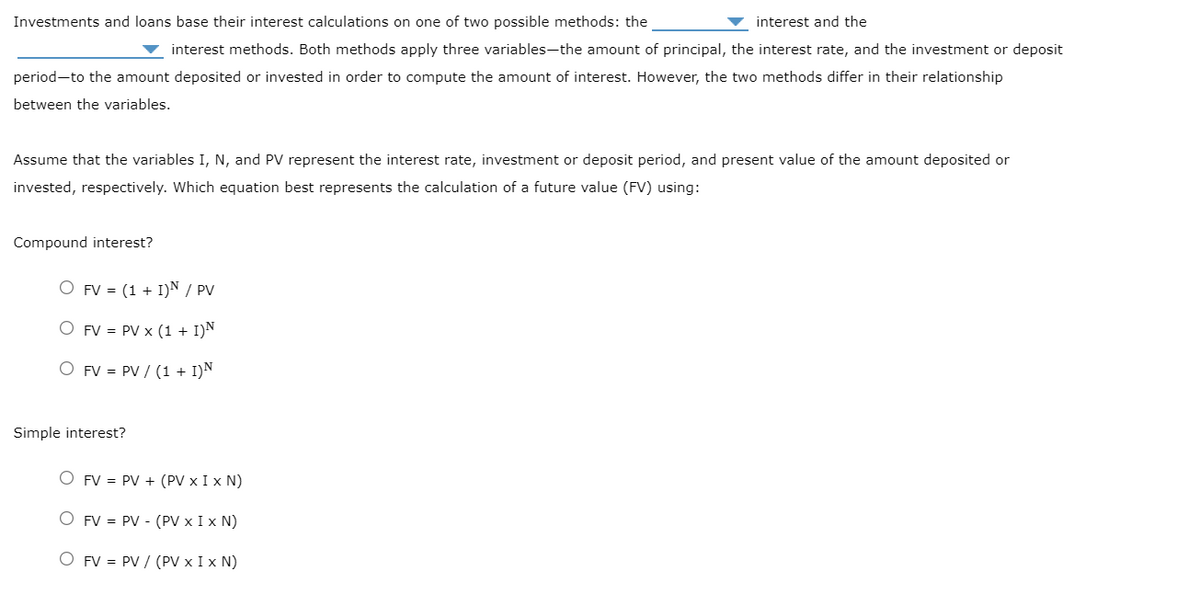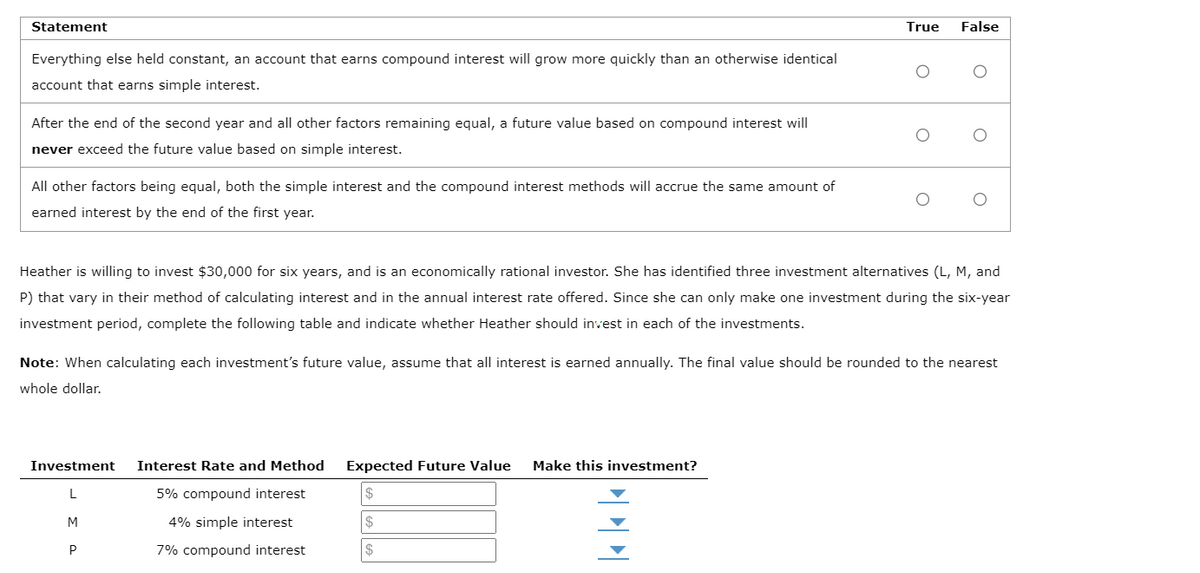Investments and loans base their interest calculations on one of two possible methods: the interest and the ▼interest methods. Both methods apply three variables-the amount of principal, the interest rate, and the investment or deposit period to the amount deposited or invested in order to compute the amount of interest. However, the two methods differ in their relationship between the variables. Assume that the variables I, N, and PV represent the interest rate, investment or deposit period, and present value of the amount deposited or invested, respectively. Which equation best represents the calculation of a future value (FV) using: Compound interest? O FV = (1 + I)N / PV O FV = PV x (1 + I)N FV = PV / (1 + I)N Simple interest? O FV = PV + (PV XI X N) O FV = PV - (PV XI X N) O FV = PV / (PV x I x N)
Investments and loans base their interest calculations on one of two possible methods: the interest and the ▼interest methods. Both methods apply three variables-the amount of principal, the interest rate, and the investment or deposit period to the amount deposited or invested in order to compute the amount of interest. However, the two methods differ in their relationship between the variables. Assume that the variables I, N, and PV represent the interest rate, investment or deposit period, and present value of the amount deposited or invested, respectively. Which equation best represents the calculation of a future value (FV) using: Compound interest? O FV = (1 + I)N / PV O FV = PV x (1 + I)N FV = PV / (1 + I)N Simple interest? O FV = PV + (PV XI X N) O FV = PV - (PV XI X N) O FV = PV / (PV x I x N)
Pfin (with Mindtap, 1 Term Printed Access Card) (mindtap Course List)
7th Edition
ISBN:9780357033609
Author:Randall Billingsley, Lawrence J. Gitman, Michael D. Joehnk
Publisher:Randall Billingsley, Lawrence J. Gitman, Michael D. Joehnk
Chapter7: Using Consumer Loans
Section: Chapter Questions
Problem 3LO
Related questions
Question

Transcribed Image Text:Investments and loans base their interest calculations on one of two possible methods: the
interest and the
▼ interest methods. Both methods apply three variables-the amount of principal, the interest rate, and the investment or deposit
period-to the amount deposited or invested in order to compute the amount of interest. However, the two methods differ in their relationship
between the variables.
Assume that the variables I, N, and PV represent the interest rate, investment or deposit period, and present value of the amount deposited or
invested, respectively. Which equation best represents the calculation of a future value (FV) using:
Compound interest?
FV = (1 + I)N / PV
FV = PV x (1 + I)N
FV = PV / (1 + I)N
Simple interest?
O FV = PV + (PV x I X N)
FV = PV - (PV x I X N)
O FV = PV / (PV x I X N)

Transcribed Image Text:Statement
Everything else held constant, an account that earns compound interest will grow more quickly than an otherwise identical
account that earns simple interest.
After the end of the second year and all other factors remaining equal, a future value based on compound interest will
never exceed the future value based on simple interest.
All other factors being equal, both the simple interest and the compound interest methods will accrue the same amount of
earned interest by the end of the first year.
Investment
L
M
P
Interest Rate and Method
5% compound interest
4% simple interest
7% compound interest
True
Expected Future Value Make this investment?
O
Heather is willing to invest $30,000 for six years, and is an economically rational investor. She has identified three investment alternatives (L, M, and
P) that vary in their method of calculating interest and in the annual interest rate offered. Since she can only make one investment during the six-year
investment period, complete the following table and indicate whether Heather should invest in each of the investments.
$
$
False
Note: When calculating each investment's future value, assume that all interest is earned annually. The final value should be rounded to the nearest
whole dollar.
O
O
O
Expert Solution
This question has been solved!
Explore an expertly crafted, step-by-step solution for a thorough understanding of key concepts.
This is a popular solution!
Trending now
This is a popular solution!
Step by step
Solved in 2 steps

Follow-up Questions
Read through expert solutions to related follow-up questions below.
Follow-up Question

Transcribed Image Text:Heather is willing to invest $30,000 for six years, and is an economically rational investor. She has identified three investment alternatives (L, M, and
P) that vary in their method of calculating interest and in the annual interest rate offered. Since she can only make one investment during the six-year
investment period, complete the following table and indicate whether Heather should invest in each of the investments.
Note: When calculating each investment's future value, assume that all interest is earned annually. The final value should be rounded to the nearest
whole dollar.
Investment
L
M
P
Interest Rate and Method
5% compound interest
4% simple interest
7% compound interest
Expected Future Value
$
$
$
Make this investment?
Solution
Follow-up Question

Transcribed Image Text:Identify whether the following statements about the simple and compound interest methods are true or false.
Statement
Everything else held constant, an account that earns compound interest will grow more quickly than an otherwise identical
account that earns simple interest.
After the end of the second year and all other factors remaining equal, a future value based on compound interest will
never exceed the future value based on simple interest.
All other factors being equal, both the simple interest and the compound interest methods will accrue the same amount of
earned interest by the end of the first year.
True False
O
O
O
O
O
O
Solution
Knowledge Booster
Learn more about
Need a deep-dive on the concept behind this application? Look no further. Learn more about this topic, finance and related others by exploring similar questions and additional content below.Recommended textbooks for you

Pfin (with Mindtap, 1 Term Printed Access Card) (…
Finance
ISBN:
9780357033609
Author:
Randall Billingsley, Lawrence J. Gitman, Michael D. Joehnk
Publisher:
Cengage Learning


Pfin (with Mindtap, 1 Term Printed Access Card) (…
Finance
ISBN:
9780357033609
Author:
Randall Billingsley, Lawrence J. Gitman, Michael D. Joehnk
Publisher:
Cengage Learning
